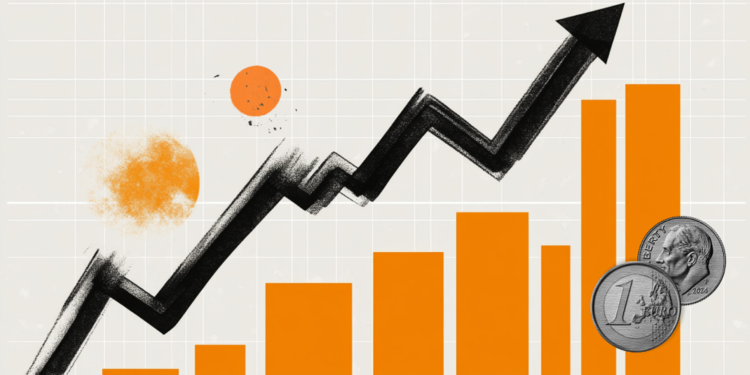EUR/USD Surge: Dollar Plummets Post-Liberation Day

- EUR/USD jumps to around 1.1145 as Trump’s tariff announcement slams the US Dollar.
- US President Trump slaps the Eurozone with 20% reciprocal tariffs.
- EU Chief von der Leyen promises retaliation if Washington talks fail.
EUR/USD is on a tear today, reaching its highest point since October, hitting about 1.1145 in Thursday’s North American session and jumping nearly 2.5%. This currency pair’s surge comes as the US Dollar (USD) feels the pressure of a long-term economic shift in the US. The US Dollar Index (DXY), which tracks the dollar against six major currencies, is taking a dive, falling to around 101.30 – a six-month low.
Just yesterday, Stephen Miran, Chair of the US Council of Economic Advisers, admitted that President Trump’s new tariffs might cause some short-term economic wobbles, but he thinks they’ll be good for the US economy in the long run. This came right after Trump dropped his plan for reciprocal tariffs. Trump’s plan includes a 10% tax on almost everything imported into the US, plus extra taxes on specific goods from many of America’s trading partners. Unsurprisingly, leaders in those countries are talking about fighting back with their own tariffs.
Traders are worried that Trump’s tariffs could trigger a global economic slowdown, and even hurt the US economy itself. Economic experts think these new tariffs are bigger than anyone expected and could actually push the US into a recession. If that happens, we could be looking at stagflation – that’s when the economy slows down but prices keep going up. These higher import taxes will likely make it harder for the Federal Reserve (Fed) to control inflation, which is already proving stubborn. It’ll definitely make the Fed’s job tougher, trying to keep inflation around 2% while also keeping people employed.
Looking ahead, everyone’s waiting for Friday’s US Nonfarm Payrolls (NFP) report for March. This key jobs report will be a major factor in shaping what people expect the Fed to do with interest rates. By the way, Wednesday’s ADP report, which gives a preview of private sector job growth, was surprisingly strong, showing 155,000 new jobs in March. That’s way better than the 105,000 that was expected and the previous month’s 84,000.
On the flip side, the latest US ISM Services PMI numbers for March were a bit of a letdown. This key indicator of service sector activity came in at just 50.8, which is quite a bit lower than the predicted 53.0 and the previous reading of 53.5.
Market Movers – Daily Snapshot: EUR/USD Surges as US Dollar Weakens
Euro PRICE Today
Check out the table below for today’s Euro (EUR) performance against other major currencies. You’ll see the Euro was strongest against the US Dollar!
| USD | EUR | GBP | JPY | CAD | AUD | NZD | CHF | |
|---|---|---|---|---|---|---|---|---|
| USD | -2.35% | -0.94% | -2.59% | -1.36% | -1.23% | -1.65% | -2.98% | |
| EUR | 2.35% | 1.18% | -0.23% | 1.04% | 1.16% | 0.73% | -0.63% | |
| GBP | 0.94% | -1.18% | -1.40% | -0.15% | -0.00% | -0.44% | -1.83% | |
| JPY | 2.59% | 0.23% | 1.40% | 1.22% | 1.41% | 0.82% | -0.43% | |
| CAD | 1.36% | -1.04% | 0.15% | -1.22% | 0.22% | -0.31% | -1.69% | |
| AUD | 1.23% | -1.16% | 0.00% | -1.41% | -0.22% | -0.43% | -1.79% | |
| NZD | 1.65% | -0.73% | 0.44% | -0.82% | 0.31% | 0.43% | -1.39% | |
| CHF | 2.98% | 0.63% | 1.83% | 0.43% | 1.69% | 1.79% | 1.39% |
This heat map gives you a quick view of how major currencies are changing against each other. The currency on the left is your ‘base’ currency, and the one across the top is your ‘quote’ currency. For instance, find ‘Euro’ on the left, then slide across to ‘US Dollar’. The number you see is the percentage change for EUR/USD (Euro as the base, US Dollar as the quote).
Technical Take: EUR/USD Targeting a Run Back to 1.1200
EUR/USD has jumped to around 1.1150 on Thursday, breaking decisively above its previous resistance level of 1.0955 – hitting levels we haven’t seen since back in early October. The short-term outlook for this pair is now looking very bullish. The 20-day Exponential Moving Average (EMA) is pointing upwards again, currently around 1.0800, confirming this positive trend.
The 14-day Relative Strength Index (RSI) is also showing strong momentum, bouncing back up to around 70.00 after a brief dip to around 60.00. This suggests the upward trend is back in force.
If we see a pullback, the area around 1.0955, which was resistance in mid-March, should now act as the first support level, with the March 31 high of 1.0850 as the next level down. On the upside, for the Euro to keep climbing, it needs to break through the September 25 high of 1.1214 – that’s the main hurdle for buyers right now.
BRANDED CONTENT
Choosing the right broker to trade EUR/USD is key, and good news – we’ve found the best ones for you! Check out their highlights and pick the one that fits your trading style.










